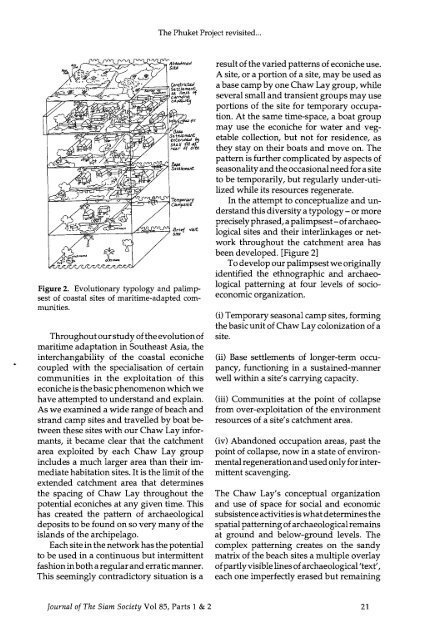The Journal of the Siam Society Vol. LXXXV, Part 1-2, 1997 - Khamkoo
The Journal of the Siam Society Vol. LXXXV, Part 1-2, 1997 - Khamkoo
The Journal of the Siam Society Vol. LXXXV, Part 1-2, 1997 - Khamkoo
You also want an ePaper? Increase the reach of your titles
YUMPU automatically turns print PDFs into web optimized ePapers that Google loves.
<strong>The</strong> Phuket Project revisited ...<br />
Figure 2. Evolutionary typology and palimpsest<br />
<strong>of</strong> coastal sites <strong>of</strong> maritime-adapted communities.<br />
Throughout our study <strong>of</strong> <strong>the</strong> evolution <strong>of</strong><br />
maritime adaptation in Sou<strong>the</strong>ast Asia, <strong>the</strong><br />
interchangability <strong>of</strong> <strong>the</strong> coastal econiche<br />
coupled with <strong>the</strong> specialisation <strong>of</strong> certain<br />
communities in <strong>the</strong> exploitation <strong>of</strong> this<br />
econiche is <strong>the</strong> basic phenomenon which we<br />
have attempted to understand and explain.<br />
As we examined a wide range <strong>of</strong> beach and<br />
strand camp sites and travelled by boat between<br />
<strong>the</strong>se sites with our Chaw Lay informants,<br />
it became clear that <strong>the</strong> catchment<br />
area exploited by each Chaw Lay group<br />
includes a much larger area than <strong>the</strong>ir immediate<br />
habitation sites. It is <strong>the</strong> limit <strong>of</strong> <strong>the</strong><br />
extended catchment area that determines<br />
<strong>the</strong> spacing <strong>of</strong> Chaw Lay throughout <strong>the</strong><br />
potential econiches at any given time. This<br />
has created <strong>the</strong> pattern <strong>of</strong> archaeological<br />
deposits to be found on so very many <strong>of</strong> <strong>the</strong><br />
islands <strong>of</strong> <strong>the</strong> archipelago.<br />
Each site in <strong>the</strong> network has <strong>the</strong> potential<br />
to be used in a continuous but intermittent<br />
fashion in both a regular and erratic manner.<br />
This seemingly contradictory situation is a<br />
result <strong>of</strong> <strong>the</strong> varied patterns <strong>of</strong> econiche use.<br />
A site, or a portion <strong>of</strong> a site, may be used as<br />
a base camp by one Chaw Lay group, while<br />
several small and transient groups may use<br />
portions <strong>of</strong> <strong>the</strong> site for temporary occupation.<br />
At <strong>the</strong> same time-space, a boat group<br />
may use <strong>the</strong> econiche for water and vegetable<br />
collection, but not for residence, as<br />
<strong>the</strong>y stay on <strong>the</strong>ir boats and move on. <strong>The</strong><br />
pattern is fur<strong>the</strong>r complicated by aspects <strong>of</strong><br />
seasonality and <strong>the</strong> occasional need for a site<br />
to be temporarily, but regularly under-utilized<br />
while its resources regenerate.<br />
In <strong>the</strong> attempt to conceptualize and understand<br />
this diversity a typology-or more<br />
preciselyphrased,apalimpsest-<strong>of</strong>archaeological<br />
sites and <strong>the</strong>ir interlinkages or network<br />
throughout <strong>the</strong> catchment area has<br />
been developed. [Figure 2]<br />
To develop our palimpsest we originally<br />
identified <strong>the</strong> ethnographic and archaeological<br />
patterning at four levels <strong>of</strong> socioeconomic<br />
organization.<br />
(i) Temporary seasonal camp sites, forming<br />
<strong>the</strong> basic unit <strong>of</strong> Chaw Lay colonization <strong>of</strong> a<br />
site.<br />
(ii) Base settlements <strong>of</strong> longer-term occupancy,<br />
functioning in a sustained-manner<br />
well within a site's carrying capacity.<br />
(iii) Communities at <strong>the</strong> point <strong>of</strong> collapse<br />
from over-exploitation <strong>of</strong> <strong>the</strong> environment<br />
resources <strong>of</strong> a site's catchment area.<br />
(iv) Abandoned occupation areas, past <strong>the</strong><br />
point <strong>of</strong> collapse, now in a state <strong>of</strong> environmental<br />
regeneration and used only for intermittent<br />
scavenging.<br />
<strong>The</strong> Chaw Lay's conceptual organization<br />
and use <strong>of</strong> space for social and economic<br />
subsistence activities is what determines <strong>the</strong><br />
spatial patterning <strong>of</strong> archaeological remains<br />
at ground and below-ground levels. <strong>The</strong><br />
complex patterning creates on <strong>the</strong> sandy<br />
matrix <strong>of</strong> <strong>the</strong> beach sites a multiple overlay<br />
<strong>of</strong> partly visible lines <strong>of</strong> archaeological'text',<br />
each one imperfectly erased but remaining<br />
<strong>Journal</strong> <strong>of</strong> <strong>The</strong> <strong>Siam</strong> <strong>Society</strong> <strong>Vol</strong> 85, <strong>Part</strong>s 1 & 2<br />
21

















